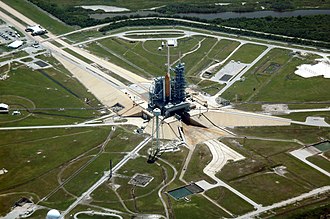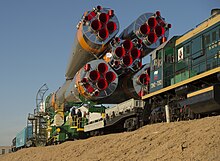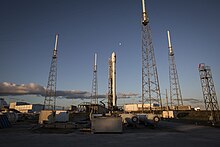Launch pad

| Part of a series on |
| Spaceflight |
|---|
 |
| History
|
|
| Spaceflight types |
| List of space organizations |
| |
|
A launch pad is an above-ground facility from which a rocket-powered missile or space vehicle is vertically launched.[1] The term launch pad can be used to describe just the central launch platform (mobile launcher platform), or the entire complex (launch complex). The entire complex will include a launch mount or launch platform to physically support the vehicle, a service structure with umbilicals, and the infrastructure required to provide propellants, cryogenic fluids, electrical power, communications, telemetry, rocket assembly,[not verified in body] payload processing,[not verified in body] storage facilities for propellants and gases, equipment, access roads, and drainage.
Most launch pads include fixed service structures to provide one or more access platforms to assemble, inspect, and maintain the vehicle and to allow access to the spacecraft, including the loading of crew. The pad may contain a flame deflection structure to prevent the intense heat of the rocket exhaust from damaging the vehicle or pad structures, and a sound suppression system spraying large quantities of water may be employed. The pad may also be protected by lightning arresters. A spaceport typically includes multiple launch complexes and other supporting infrastructure.
A launch pad is distinct from a missile launch facility (or missile silo or missile complex), which also launches a missile vertically but is located underground in order to help harden it against enemy attack.
The launch complex for liquid fueled rockets often has extensive ground support equipment including propellant tanks and plumbing to fill the rocket before launch. Cryogenic propellants (liquid oxygen oxidizer, and liquid hydrogen or liquid methane fuel) need to be continuously topped off (i.e., boil-off replaced) during the launch sequence (countdown), as the vehicle awaits liftoff. This becomes particularly important as complex sequences may be interrupted by planned or unplanned holds to fix problems.
Most rockets need to be supported and held down for a few seconds after ignition while the engines build up to full thrust. The vehicle is commonly held on the pad by hold-down arms or explosive bolts, which are triggered when the vehicle is stable and ready to fly, at which point all umbilical connections with the pad are released.
History
Precursors to modern rocketry, such as fireworks and rocket launchers, did not generally require dedicated launch pads. This was due in part to their relatively portable size, as well as the sufficiency of their casings in sustaining stresses. One of the first pads for a liquid-fueled rocket, what would later be named the Goddard Rocket Launching Site after Robert H. Goddard's series of launch tests starting in 1926, consisted of a mount situated on an open field in rural Massachusetts. The mount was compromised of a frame with a series of gasoline and liquid oxygen lines feeding into the rocket.
It wasn't until the 1930s that rockets were increasing enough in size and strength that specialized launch facilities became necessary. The Verein für Raumschiffahrt in Germany was permitted after a request for funding in 1930 to move from farms to the Berlin rocket launching site (German: Raketenflugplatz Berlin), a repurposed ammunition dump.[2]
A test stand was built for liquid-propellant rockets in Kummersdorf in 1932, where the early designs from the Aggregat series of ballistic missiles were afterwards developed. This site was also the location of the first casualties in rocket development, when Dr. Wahmke and 2 assistants were killed, and another assistant was injured. A propellant fuel tank exploded, while experimenting with mixing 90% hydrogen peroxide and alcohol, before combustion.[3]: 35 [4]: 52–53
In May 1937, Dornberger, and most of his staff, moved to the Peenemünde Army Research Center on the island of Usedom on the Baltic coast which offered much greater space and secrecy. Dr. Thiel and his staff followed in the summer of 1940. Test Stand VI at Pennemünde was an exact replica to Kummersdorf's large test stand.[3]: 56, 60 [4]: 57 It was this site which saw the development of the V-2 rocket. Test Stand VII was the principle testing facility at the Peenemünde Airfield and was capable of static firing rocket motors with up to 200 tons of thrust.
Launch pads would increase in complexity over the following decades throughout and following the Space Race. Where large volumes of exhaust gases are expelled during engine testing or vehicle launch, a flame deflector might be implemented to mitigate damage to the surrounding pad and direct exhaust. This is especially important with reusable launch vehicles to increase efficiency of launches while minimizing on time spent refurbishing.
Transport of rockets to the pad



Each launch site is unique, but a few broad types can be described by the means by which the space vehicle gets to the pad.[citation needed]
- Horizontally integrated rockets travel horizontally with the tail forward to the launch site on a transporter erector launcher and are then raised to the vertical position over the flame duct. Examples include all large Soviet rockets, including Soyuz, Proton, N1, and Energia. This method is also used by the SpaceX and Electron launch vehicles.
- Silo launched rockets are assembled inside of a missile silo. This method is only used by converted ICBMs due to the difficulty and expense of constructing a silo that can contain the forces of a rocket launch.
- Vertically integrated rockets can be assembled in a separate hangar on a mobile launcher platform (MLP). The MLP contains the umbilical structure and is carried to the launch site on a large vehicle called Crawler-transporter. Launch Complex 39 at the Kennedy Space Center is an example of a facility using this method.[5] A similar system is used to launch Ariane 5 rockets at ELA-3 at Guiana Space Centre.
- Vertically assembled vehicles can also be transported on a mobile launcher platform resting on two parallel standard gauge railroad tracks that run from the integration building to launch area. This system is still in use for the Atlas V and future Vulcan.
- At SLC-6 and SLC-37, rockets are assembled on the launch mount. A windowless rail-mounted building encloses the launch pad and gantry to protect the vehicle from the elements, and for purposes of military secrecy. Prior to launch,[6] the building is rolled away. This method is also used at Kagoshima for the M-V.
- The former Sea Launch service used the converted self-propelled oil drilling platform Ocean Odyssey to transport Zenit 3SL rockets horizontally to the Equator, and then to erect and launch them from a floating launch platform into geostationary transfer orbits.
See also
- Ground segment – Ground-based elements of a spacecraft system
- Launch vehicle – Rocket used to carry a spacecraft into space
- List of rocket launch sites
- Missile launch facility
- Non-rocket spacelaunch
- Pad abort test – test of a spacecraft's launch abort systemPages displaying wikidata descriptions as a fallback
- Rocket launch
- Service structure – Structure built on a rocket launch pad to service launch vehicles
- Spaceport
- Stratolaunch Systems – American space transportation venture
- Transporter erector launcher – Self-propelled heavy missile systems
References
- ^ Wragg, David W. (1973). A Dictionary of Aviation (first ed.). Osprey. p. 175. ISBN 9780850451634.
- ^ "Highlights in German Rocket Development". Archived from the original on 21 August 2007. Retrieved 14 June 2016.
- ^ a b Dornberger, Walter (1954). V-2. New York: The Viking Press, Inc. pp. 27–42.
- ^ a b Fleischer, Wolfgang (1997). The Wehrmacht Weapons Testing Ground at Kummersdorf. Atglen: Schiffer Publishing Ltd. pp. 9–46. ISBN 9780764302732.
- ^ "LAUNCH COMPLEX 39, PADS A AND B". NASA KSC. 1992. Archived from the original on 2008-09-21.
- ^ "Cpsb Launchpad". Viswanath. 2023. Archived from the original on 2023-06-16. Retrieved 2023-06-16.












